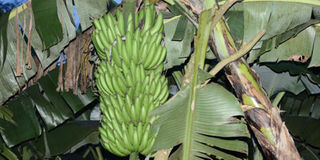Prime
How to earn more from bananas

Naroban varieties are disease resistant yet with good yields. PHOTO/GEORGE KATONGOLE
The Seeds of Gold Farm Clinic at the National Agricultural Research Laboratories (NARL) Kawanda was an eye opener to profitable banana farming. Great strides have been made by researchers to contribute towards food safety and commercialisation, yet there is little progress being made in making banana farming profitable.
Early breeding efforts focused on resistance to nematodes, tolerance to weevils and high performance in good seasons in terms of bunch size, but the hybrids were inferior in terms of consumption.
According to the Food and Agriculture Organisation (Fao), Uganda is the second top producer of bananas behind India with 10.2 million tons per year. Bananas are an important food in terms of food security. It is estimated that 75 per cent of Ugandan farming households grow the crop on more than 38 per cent of utilised arable land.
There is a reported decline however, with bunches dropping from 60kg to 10kg due to pests (banana weevil and nematodes), diseases (black Sigatoka, banana bacterial wilt), soil fertility decline, socio-economic constraints (high costs of managing crops, competition for labour with other enterprises, marketing difficulties) and low genetic diversity.
The National Banana Research Program (NBRP) initiated a breeding program in 1994 but the latest products on offer is the NaroBan5 (M30).
Dr Asher Wilson Okurut, a banana specialist at the station, hints that the failure to adopt new farming practices is also keeping production low.
“Farmers are copying and pasting practices from their ancestors but to increase production, they should have a commercial mind,” he says, noting that the country has a production deficit of 60MT.
What exactly is the problem? Okurut points at three reasons; inferior varieties, poor agronomic practices and poor soil management.
Fertilisation
Dr Okurut says water availability and fertility of the soil are key components in successful banana growing.
Being a long duration crop, the total water requirements of bananas are high. Water requirements per year vary between 1200 mm to 2200. For rain-fed production, average rainfall of 2000 to 2500 mm per year, well-distributed, is desirable, but bananas often grow under less rainfall.
He says that a farmer must pay attention to soil and plant health. “The farmer, soil and plant must synergise. The soil is the biological bank which keeps micro-organisms. But this is not enough to run the business. That means you must add other deposits in the form of fertilisers (both mineral fertilisers and manure),” Dr Okurut stresses.
He says attention must be paid to the four major fertilisation factors (the 4Rs): right rate, right source, right placement, and right timing.
He explains that each fertiliser has its own advantages. Manure has a higher cation-exchange capacity which helps in keeping more water in the soil as it has binding matter.
Dr Okurut does not recommend liquid fertilisers in banana farming. “There is no need to bypass the soils in any long-term fertilisation program”
Routine management
As the plants grow, de-suckering is a recommended activity. The recommendation is three to five suckers. Farmers are advised to obtain an uprooting spear.
Other practices Dr Okurut recommends is de-trashing by removing hanging dry leaves routinely.
The stability of the plant is also maintained by mattocking which is the removal of pseudostem after harvesting of fruit. The pseudostem should be cut leaving a stump of about 0.6m.




